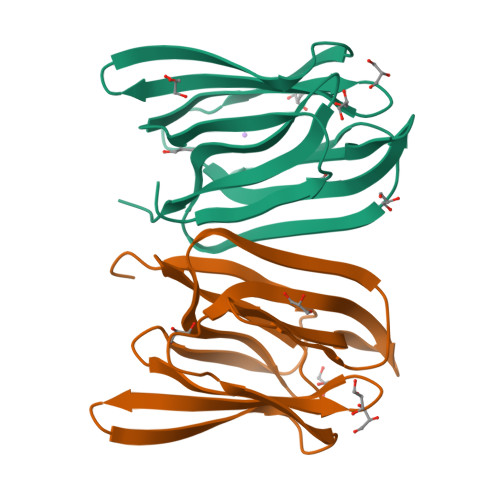Engineering a Therapeutic Lectin by Uncoupling Mitogenicity from Antiviral Activity.
Swanson, M.D., Boudreaux, D.M., Salmon, L., Chugh, J., Winter, H.C., Meagher, J.L., Andre, S., Murphy, P.V., Oscarson, S., Roy, R., King, S., Kaplan, M.H., Goldstein, I.J., Tarbet, E.B., Hurst, B.L., Smee, D.F., de la Fuente, C., Hoffmann, H.H., Xue, Y., Rice, C.M., Schols, D., Garcia, J.V., Stuckey, J.A., Gabius, H.J., Al-Hashimi, H.M., Markovitz, D.M.(2015) Cell 163: 746-758
- PubMed: 26496612
- DOI: https://doi.org/10.1016/j.cell.2015.09.056
- Primary Citation of Related Structures:
4PIF, 4PIK, 4PIT, 4PIU - PubMed Abstract:
A key effector route of the Sugar Code involves lectins that exert crucial regulatory controls by targeting distinct cellular glycans. We demonstrate that a single amino-acid substitution in a banana lectin, replacing histidine 84 with a threonine, significantly reduces its mitogenicity, while preserving its broad-spectrum antiviral potency. X-ray crystallography, NMR spectroscopy, and glycocluster assays reveal that loss of mitogenicity is strongly correlated with loss of pi-pi stacking between aromatic amino acids H84 and Y83, which removes a wall separating two carbohydrate binding sites, thus diminishing multivalent interactions. On the other hand, monovalent interactions and antiviral activity are preserved by retaining other wild-type conformational features and possibly through unique contacts involving the T84 side chain. Through such fine-tuning, target selection and downstream effects of a lectin can be modulated so as to knock down one activity, while preserving another, thus providing tools for therapeutics and for understanding the Sugar Code.
Organizational Affiliation:
Division of Infectious Diseases, Department of Internal Medicine, Program in Immunology, University of Michigan, Ann Arbor, MI 48109, USA; Division of Infectious Diseases, Department of Medicine and UNC AIDS Center, University of North Carolina, Chapel Hill, NC 27599, USA.


















